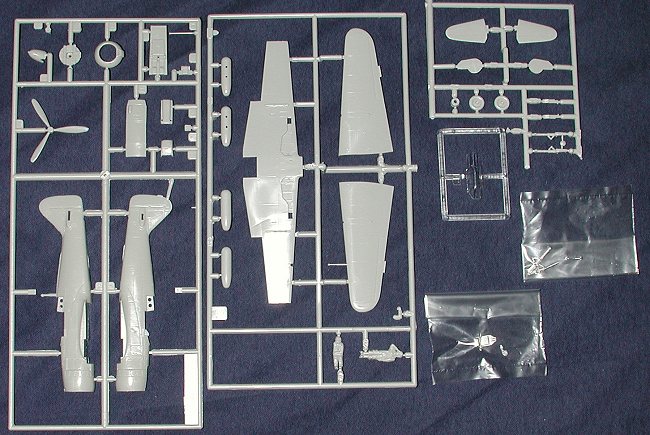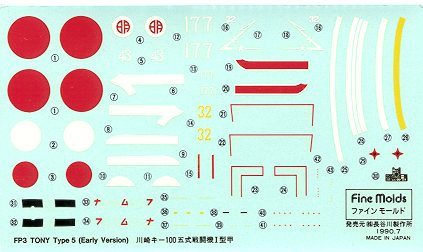 '
'|
KIT: |
Fine Molds 1/72 Ki-100 |
|
KIT # |
FP 3 |
|
PRICE: |
@$25.00 |
|
DECALS: |
Three aircraft |
|
REVIEW & |
|
|
NOTES: |
Includes white metal parts |
 '
'
|
HISTORY |
In 1944, the folks at Kawasaki had a problem with the Ki-61. While airframe construction was going well, engine production was lagging far behind. So much so that there were airframes all over the factory awaiting engines. With a war going on, this was not considered to be a good thing. There was also the need to upgrade the engines in the Ki-61, but frankly, there were not enough engines around that were small enough and powerful enough to fit the need. Actually, the only suitable engine with enough power was a large 1,500 hp Mitsubishi 14 cylinder, double-row radial.
Deciding to give it a shot anyway, Kawasaki engineers went about trying to adapt a 4 foot wide engine into a 2 foot 9inch wide Ki-61. Some creative engineering and aerodynamic smoothing was applied and the engine was finally fit in, the first prototype flying in February of 1945. Much to everyone's delight, the aircraft that was produces was superior in almost every way to the Ki-61. It was lighter, more maneuverable, had better climbing speed and a higher ceiling. The only down side was that it was a few miles per hour slower. No big deal when the plan was to use it to get to the B-29s that were making themselves a major nuisance, what with bombing and all.
The superb handling and ease of flying gave even the most inexperienced pilots a chance against American fighters. In the hands of an expert, they were easily a match for anything the US could put against it. As was typical of late war projects, it was too little and too late. Nearly 400 were eventually built, over half of them modified Ki-61 airframes. Thankfully, one still exists in the UK and has been lovingly restored.
|
THE KIT |

Once you get past the sticker shock of forking out so much money for a 1/72 single engined fighter, you will discover a kit that in all ways looks very much like a contemporary Fujimi or Hasegawa kit. Finely engraved panel lines, good detailing and only a few ejector pin marks to worry about. The cockpit is basically a floor, seat, control stick and instrument panel. There is some detailing on the fuselage side walls. The instrument panel is a decal. The only option is to have drop tanks or not. If you don't want the wing racks, you'll have to sand them off as they are part of the lower wing molding. The canopy is a single piece so you can't display an open cockpit unless you cut it.
The metal bits are for the seat, stick, and landing gear. The metal landing gear appear to be better detailed than the plastic ones. You also get two pilot figures. One for the cockpit and another standing. The seated one has a nice large sink mark right in the center of his chest. Good luck fixing that!
 The instructions are just like
any Hasegawa kit and are set up the same way. According to the parts diagram,
one of the sprues has most of the Ki-61 fuselage, prop and spinner. That wasn't
in my kit. However I bought this kit at a swap meet at something less than full
retail and it was already open, so I assume that the previous owner took those
parts as the sprue that is left appears to have been broken off. Decals are for
three aircraft. They are all Kawasaki Army Green uppers with natural metal
undersides and yellow IFF bands on the leading edges of the wings. Since Gunze
doesn't make a Kawasaki Army Green, there is a complicated formula for mixing
four colors to get it. A five color mixture is for the green-grey that the
control surfaces are painted. The three units are the Akeno school, 59th
squadron and 244 squadron. Decals are typical Japanese and will need hot water
to apply properly.
The instructions are just like
any Hasegawa kit and are set up the same way. According to the parts diagram,
one of the sprues has most of the Ki-61 fuselage, prop and spinner. That wasn't
in my kit. However I bought this kit at a swap meet at something less than full
retail and it was already open, so I assume that the previous owner took those
parts as the sprue that is left appears to have been broken off. Decals are for
three aircraft. They are all Kawasaki Army Green uppers with natural metal
undersides and yellow IFF bands on the leading edges of the wings. Since Gunze
doesn't make a Kawasaki Army Green, there is a complicated formula for mixing
four colors to get it. A five color mixture is for the green-grey that the
control surfaces are painted. The three units are the Akeno school, 59th
squadron and 244 squadron. Decals are typical Japanese and will need hot water
to apply properly.
Overall, a nice looking kit. One that I have not seen built, but it shouldn't be that difficult.
|
REFERENCES |
Japanese Aircraft of the Pacific War by Rene J Francillon, Putnam, 1979
Review copy courtesy of me and my wallet!
If you would like your product reviewed fairly and quickly by a site that has over 2,000 visits a day, please contact me or see other details in the Note to Contributors.